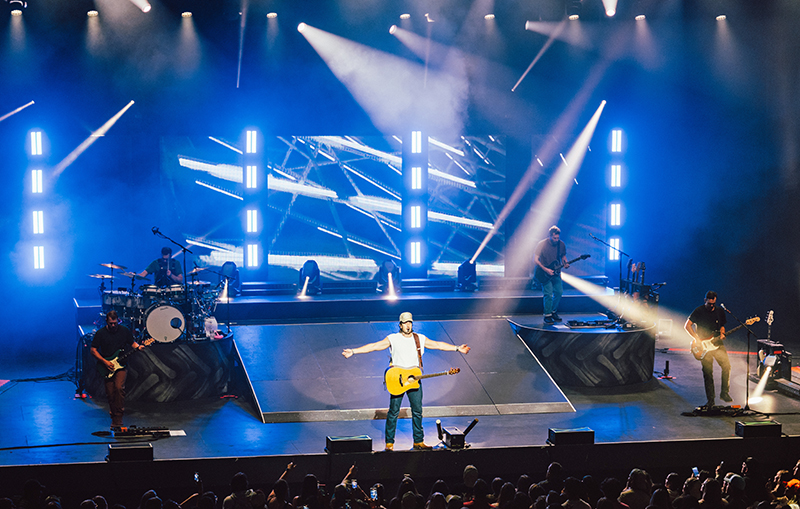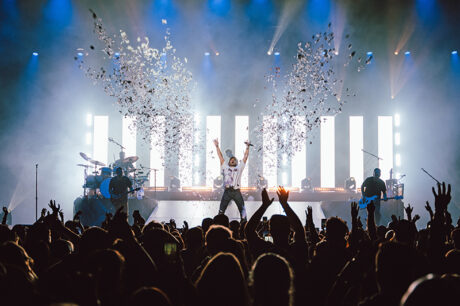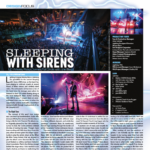
Russell Dickerson’s career began with four consecutive U.S. Country Airplay No. 1s and he has since released three albums, resulting in a further collection of hits. His Big Wheels & Back Roads Tour has been playing to enthusiastic audiences filling theaters and pushing Dickerson to the next level. Scott Cunningham of Cut2Black Designs, the Production/Lighting Designer and Co-Programmer, has an established ongoing working relationship with the singer, having first worked with him in the summer of 2017 when Dickerson was opening up on tour with Florida Georgia Line. Cunningham’s design ensures a production setting that supports Dickerson’s blend of country pop style. Cunningham worked with Associate Programmer Luke Elrod and Lighting Director Nathan Augustyn. PLSN caught up with Cunningham as the tour prepared to set back out on the next leg.
Does Russell Dickerson have a lot of input on the design?
He does. Russell’s very intuitive, very involved. We usually go through two or three concepts and then go through 10 or 11 versions. Working with Russell over the years on several different designs I’ve been able to learn a little bit of his ‘methods and madness’. I love that he gives input because I know that he’s feeling good about an idea or if he’s got questions and concerns that are easy to quickly address. He’s very smart and knows how to relay what he wants and then it’s our job to translate that to the design. Russell is a very active performer, so I want to give him the space he needs; a large stage space and runways are key for him. Hence, on this tour the large upstage ramp and catwalk.

What was your design concept for this tour?
The tour is called Big Wheels, so we took the wheel approach literally and incorporated that into the set design. We had some custom fabric fascias of tractor tires made by Sew What? in L.A. that we put around the two side risers supplied by Gallagher Staging. The drums and the upstage left guitar auxiliary player are on half circle risers that give the look of tractor tires lying on their sides. A big part of this tour was that he really wanted to incorporate video. He had not done that before. So, the concept was to start there and work it out, knowing that the tour would be primarily ground supported going into larger clubs. We weren’t fully sure the direction we would take with video content at the time, so I pitched him a couple of different ideas with the tiles being split into different designs. Since we didn’t have content made at that point, I didn’t want to really approach it with a full 16:9 wall. I took a little bit more creative approach. It’s a bit of a full wall feel, but it’s really got broken up tiles; it doesn’t feel like that same wall you might always see. It is made up of separate pieces. As I said, at first, we didn’t know for sure what we wanted in content. As we got deep into rehearsal, we realized there were a handful of songs that really needed full on content creation, music video-style, that kind of stuff. The lighting has always had a very high dynamic for Russell’s shows, but on this one we wanted a few songs that stick to a little more creative LED, so there’s a few songs where LED drives. Some are a couple of lyric style videos, and then a couple are imagery videos highlighting his career. Some of his number ones have more of a photoscape. His song, “Yours” kind of walks through his career.
Who did the content?
The company is called AYA Creative. It was my first time working with them, and fortunately we were able to come together and create some incredible ideas to match the pace of the lighting of the show. Daniella [Mason] has been a part of a number of other creative projects with Russell, having done some music videos for him. She and her AYA creative team busted out some incredible content to really enhance the show.
Are you doing any affected I-Mag?
Actually, we’re straight content; all videos and effects. We have no I-Mag at all. Doing mostly clubs, theaters, and such, it’s really not conducive for needing to carry cameras. They’re a lean mean crew on the bus that are knocking it out of the park every show.

What were some of the solutions you brought to design challenges for this tour, considering you have different size venues?
Working with our Lighting and Video vendor Integrated Production Solutions (IPS), we knew we had to create a solution for ground support of the LED tiles in an effective and efficient way. So, the upstage video wall is actually on three fabricated carts. They were originally built for another tour, but IPS had them and we thought they would be perfect to deploy on this, so they customized them to the design. It’s easier if we don’t need to set up a bunch of tiles every day. It also lets us have the ability to peel off some tiles from each cart and squeeze them accordingly, which is obviously a big bonus for club tours because you never know what you’re going to get every day. So, we have scalability there.
We were also able to work with Gallagher Staging to create a ramp solution that was suitable for Russell’s style show. We have the ability to squeeze the ramp a little bit, or we can pull the ramp from the show and just put the risers out there; that is not the preferred solution, but some stages are just too small to fit everything. We just roll out the drum riser and the accessory player riser skipping the ramp and still fit the rest of the production.
Talk about your lighting design and the challenge of creating so many looks over the course of the performance.
The gear list isn’t huge; actually we’re a three-fixture tour. I love to choose fixtures packed with features. Russell loves high energy and wants everything so dynamic. He doesn’t like to ‘pace’ the show and save anything for later; so we have to use almost every feature the fixtures have so that we don’t feel like we’re doing the same thing over and over during the show.
What were your gear choices and why did you choose them?
I have Elation Smarty Hybrids, CHAUVET PXL Bar 16s, and the ADJ Jolt Panels. It is all controlled on an MA console [grandMA3 light], we are also triggering the [PRG] Mbox straight from the MA, so everything’s on timecode through the console. I chose the Elation Smarty Hybrid fixture to give us both options as a spot fixture and a beam fixture. Every tour we’ve done, Russ can’t wait to see the ‘beam looks’ created. So, we’ve got a couple of the [hazebase] Fab Hazers in there to give some beamage. That’s always been a priority to get beams and punch. We have been super impressed with The Fab, it has been rock-solid, and the output is great, especially for the venues that we’re playing.
I also dove in on the ADJ Jolt Panels. Russell’s is a very high impact show, so we knew we needed some kind of strobe and wanted to go with something that offered the versatility of both a pixel color wash and strobe/blinder in one fixture. Financially, the budget for motorized fixtures just wasn’t there. And, to be honest, we just didn’t need the tilt function. In fact, for most of the tours that I put motorized panels on, the tilt function isn’t a necessity. So, I had been hoping that someone would come out with a static version for a while. When Chuck [Dillingham of ADJ rep firm Freed Sales] showed me the Jolt Panel FX I was instantly impressed. The intensity blows other fixtures away and it has all the functionality but at a price that works for a lot of the smaller bus and trailer tours. For Russell, it was a really obvious choice, not just budget-wise, but because it was the perfect fixture for what we needed. We have them in 81-channel mode, which gives us 20 segments of color as well as the six strobe segments. This allows us to create a variety of different wipes and other pixel effects as well as using the fixtures to create big blinder looks and flood the stage with vibrant color. The color wash is great, the strobe/blinder hits are really intense, and the pixel mapping allowed us to make use of the panels almost all the way through the show.”
Are you using any special effects?
We are currently using cryo for effects, and of course the haze for the lighting. We are using the cryo [CO2 Cryo Jets supplied by Pyrotek] to over accent the high energy of the show; it’s an incredible tool providing that extra punch and dynamic to the show when it feels like we’ve pulled out all the tricks.
What do you think others might notice in this design?
The phrase “big things come in small packages.” I think the amount of production we’re able to pack into one semi-truck; but also, the looks we are able to create with what could seem like, well I guess is, a minimal gear list.
How has the support of your vendors, Gallagher and IPS (Integrated Production Solutions) been?
Gallagher’s been great on every project I’ve done. They’re my first call and working with Tye [Trussell] is always a pleasure. Everything that comes out of there has always been a hundred percent without any issues. And IPS is also great. I’ve been working alongside them for about three years. Though they are a little bit smaller than some of the larger production shops their support has always been incredible. They work with us on all aspects, whether budget-wise, personnel-wise, support-wise, they help us get out the door. Like those LED carts, they bring us ideas of ways to help make the whole show happen.
Any other thoughts on designing the Russell Dickerson tour?
It’s always an honor working with any client who trusts me and Cut2Black Designs, Russell’s been loyal to me for about five years now. Even through the pandemic, having me create designs of all scales. I appreciate and really enjoy working with him and the whole camp. This one is our biggest one yet and I can’t wait to see what comes next.


